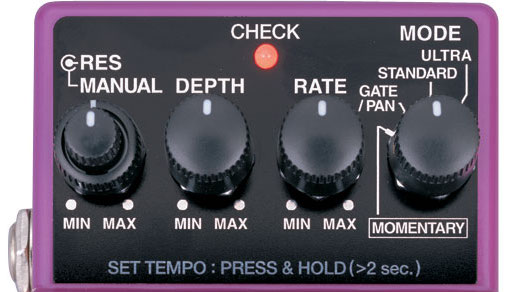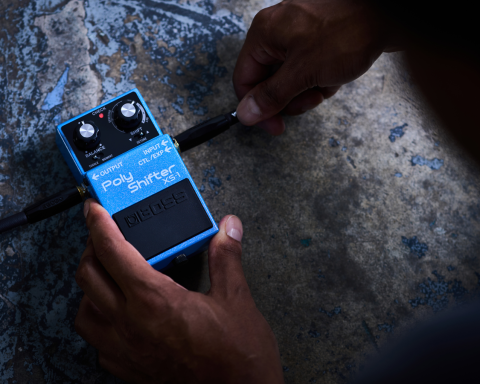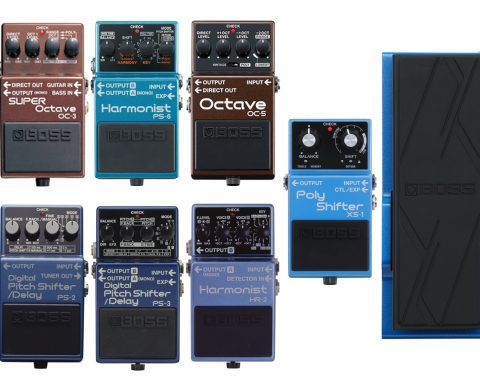Flanger is one of the three core modulation effects, alongside chorus and phaser. Some overlook flanger as the least subtle and most overpowering of the three. While it can turn a guitar into a swirling jet engine, flanger also creates a nuanced tape machine-style warble that’s the icing on the cake of any psychedelic solo. Discover how to maximize this powerful sonic tool.
What is a Flanger?
Flanger is a time-based modulation effect that duplicates the guitar signal and delays it fractionally while shifting the delay time via an LFO. This function creates a swirling harmonic effect that can sound as natural as a tape player running slightly off or as seismic as a sci-fi raygun.
Many legendary guitarists have called upon flanger pedals to enhance a solo, thicken a riff, or simply make weird noises. It’s been essential to Eddie Van Halen’s signature sound and is reportedly the only modulation effect on Bruce Springsteen’s pedalboard.
History of the Flanger
Like many effects, flanger emerged organically in a studio decades ago, probably through a happy accident. The first recorded use of flanger was by legendary guitarist Les Paul in 1949, although many credit The Beatles with popularizing the effect a decade later.
Initially, the effect was created by playing identical source material on two tape machines simultaneously while physically applying pressure to the tape guide of one device. The result was the sweeping cascade of jet-like sonic motion that we replicate today through analog and digital stompboxes and multi-effects.
"Flanger was created by playing identical source material on two tape machines simultaneously while physically applying pressure to the tape guide of one device."
Flanger became a widespread effect during the 1960s. Classic examples include Jimi Hendrix’s tasteful, psychedelic flanging on “Axis: Bold as Love.” However, the introduction of flanger in stompbox form in the 1970s kickstarted its popularity. From Bowie to Van Halen, flanger became a mainstay of popular music. Listen to the wild flanging on the piano intro to Bowie’s “Ashes to Ashes.”
Setup Considerations
As a modulation effect, flanger belongs in the middle of an effects chain. Position the effect after compressors, boosts, or overdrives but before delay or reverb pedals. Flanger aims to excite those drive tones but not to muddy any time-based effects, which will benefit from being as clean as possible. Some flanger pedals, like the BOSS BF-3, have a stereo option. This feature allows the swooping flange effect to shift between two speakers, broadening and intensifying its movement.
FIVE FLANGER PEDAL USES
Tape Warble
While many sounds flanger pedals create are soaring sonic maelstroms, this effect can also produce subtle vintage-inspired modulation. Though not an overt use of flanger, this use adds real character to any guitar tone. The aim is to create a gentle shift in tone, like an old tape player running at a slightly inconsistent speed. To achieve this:
- Set both the resonance and the rate of the effect relatively low
- Experiment with setting the rate as low as possible while still being able to hear the effect’s movement
- Set the depth between 10 and 12 o’clock so the movement is audible but not overpowering
The result is classic lo-fi tone thickening, perfect for picked sections, gentle chords, or simple basslines.
Jet Engine
At the other end of the spectrum, using a flanger as a special effect can be fun—something brash to transform a guitar tone completely. We popularly refer to this as a jet engine effect because using a flanger this way resembles the swirling sonic distortion of a plane takeoff.
The bold musical tastes of the 1980s popularized this use of the effect. Still, one of the most outstanding examples of the effect is Eric Johnson’s 1990 track, “High Landrons.” This track’s constantly shifting, swirling flanger effect is a pulse alongside his elegant soloing.
To replicate this sound, set the regeneration and depth controls relatively high. Then set the rate around 10-12 o’clock to make the most out of that swooshing, cascading movement. The BOSS BF-3 Ultra setting increases the depth and ferocity of the flanging effect even more.
"The BOSS BF-3 Ultra setting increases the depth and ferocity of the flanging effect even more."
Van Halen Sound
The flanger pedal constituted an essential part of Van Halen’s coveted sound. Although not as overbearing as some ’80s shredders’ use, it was still a key element, adding movement and character to riffs and solos.
A great example of Eddie Van Halen’s use of the flanger is on the 1981 track “Unchained.” The shifting swirling effect of the flanger makes the lead riff pop. To achieve this, set the rate around 2 o’clock and the depth slightly higher. Be gentle with the regeneration control, dialing in only the necessary amount. At its best, the effect should support, not overpower, the natural tone.
Slicer Style
The BOSS BF-3 comes equipped with a gate/pan mode. This mode is fantastic for utilizing the stereo capabilities of the pedal. Yet when used in mono, the effect acts as a slicer or tremolo. The rate control becomes the tremolo speed, with the flanging alongside the chopped guitar signal.
This can be a great way to get two effects from a single pedal. Players can set very the slicing effect to a fast rate, and it has a naturally high depth. This combination can create robotic ring-mod style tones, perfect for the outlandish guitarist.

Auto Wah
Flangers have a surprisingly comprehensive range of tones within their grasp. An exciting usage is turning a flanger into an auto-wah. This approach can sound unique and extracts an extra effect from one pedal.
To achieve this, set the res and manual control relatively low to limit the range of the frequency movement to somewhere similar to a wah pedal. Then set the depth to a little over 12 o’clock and the rate to a fast speed, rhythmically matched to the guitar part.
"A flanger is a worthwhile extension of a pedalboard, great for subtle thickening and full-on jet fly-bys alike."
Unique, Dynamic, Highly Musical
Flanger is a unique, dynamic, and highly musical effect. Often overlooked as being specifically for ’80s hair metal, this couldn’t be further from the truth. A flanger is a worthwhile extension of a pedalboard, great for subtle thickening and full-on jet fly-bys alike. It also blends beautifully with other effects types.






